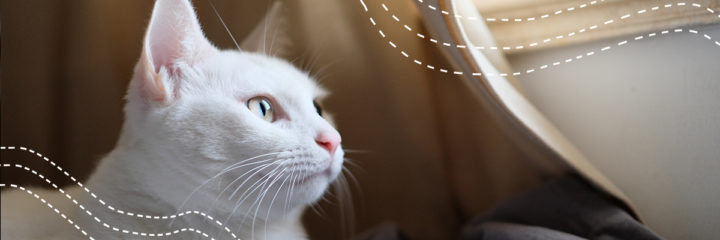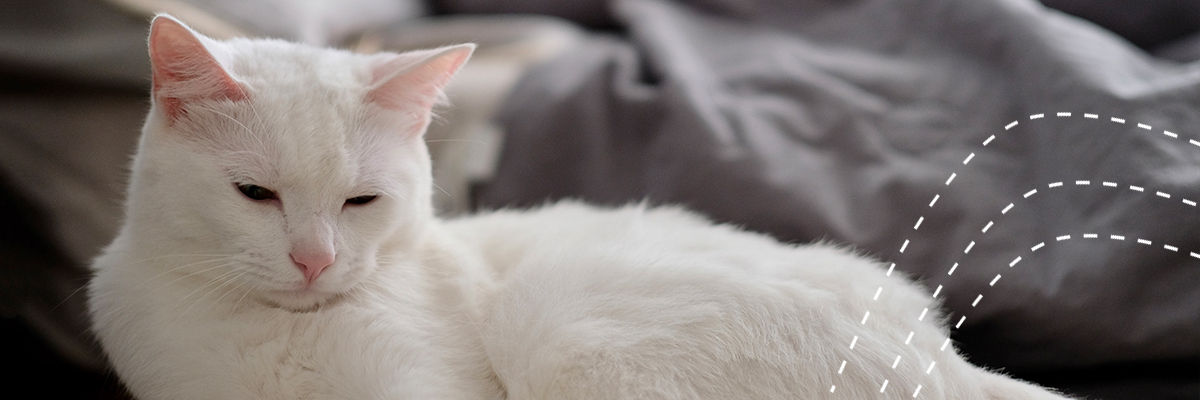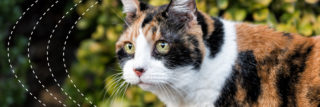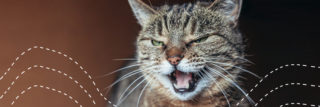
Zusammenfassung
- Stage 3 of chronic kidney disease is characterised by increasing symptoms
- Uraemic toxinsToxic, nitrogen-containing urinary substances responsible for uraemia and kidney damage.... show a significant influence on clinical symptoms
- There are measures of varying effectiveness to reduce uraemic toxins
According to IRIS (International Renal Interest Society), the third stage of chronic kidney disease (CKD) is characterised by clinical signs. If the symptoms are mild, the cat is in early stage 3, if the clinical symptoms are numerous and severe, the cat is in late stage 3 according to IRIS.
Stage 3
Due to the increasingly reduced kidney performance (up to 25% remaining), more urinary substances are retained, which have an effect on the cat’s body. Not only the blood count shows clear alterations, such as an increase of the creatinineCreatinine is a breakdown product of muscle metabolism. Its blood level is dependent, among many factors, on age, weight, nutritional status and muscle mass. Hence, creatinine levels in the blood vary from individual to individual. Creatinine is continuously excreted in the urine. Increased blood creatinine... blood level to a value of 251-440 μmol/l or 2.9-5.0 mg/dl and the SDMASDMA = Symmetrical Dimethylarginine, which is a degradation product of the amino acid arginine and is excreted solely through the kidneys. SDMA is a highly specific biomarker for kidney function in cats. Read more: SDMA test (blood test)... value in the blood of 26-38 μg/dl. The urine examination usually shows a UPC (urine protein-to-creatinine-ratio) value above 0.4, which according to IRIS corresponds to proteinuriaIncreased protein in urine, leading to loss of protein. Normally, only a very small amount of protein is excreted in the urine. In chronic kidney disease, the amount lost may increase. High blood pressure damages blood vessels in the nephrons making them more permeable and....
Especially the reduced excretion of toxic waste products of protein metabolism such as uraemic toxins and here especially indoxyl sulphate have a considerable influence on the clinical symptoms. They are one of the main causes of clinical symptoms in CKD. Uraemic toxins such as indoxyl sulphate are significantly linked to the progression and mortality of chronic kidney disease in humans. In cats and dogs, this connection is also seen in recent publications. Indoxyl sulphate is involved in extensive processes in the kidney and other organs (e.g. brain, heart, bones, muscles, intestines) and leads to an impairment of organ functions and inflammatory reactions. Indoxyl sulphate also has a negative influence on:
- general immune state (→ is reduced),
- blood pressure (→ increases),
- anaemia (→ is enhanced)
- and the phosphate level (→ is increased).
Indoxyl sulphate further fuels the vicious circle of kidney destruction.
Likewise, phosphate is retained and accumulates in the blood. This leads to hyperphosphataemiaIncreased phosphate in the blood.. This sets in motion a vicious circle of further kidney destruction, leading to a variety of problems in CKD via the activation of parathyroid hormoneParathyroid hormone (PTH) is a hormone secreted by the parathyroid glands, which regulates calcium levels in the blood. PTH is secreted in response to low blood calcium levels (hypocalcaemia). An increase in calcium concentration above the normal value inhibits PTH production (negative feedback). PTH stimulates..., which can also result in clinical symptoms.
In addition to a reluctance to eat, polydipsiaExcessive thirst due to illness, leading to excessive production of urine (polyuria).... and polyuriaExcessive production of urine, potentially due to kidney failure.... as well as weight loss, vomiting, nausea, faintness, diarrhoea, weakness, bad breath and a shaggy coat appear as clinical symptoms in the stage 3.
Phosphate reduction
The focus is on slowing down the progression of CKD and improving quality of life by reducing clinical symptoms. Since the kidneys are no longer able to excrete enough phosphate, phosphate intake should be reduced. This can be achieved by feeding phosphate-reduced food (kidney diets). Since muscle meat and innards contain a lot of protein, wheat gluten is usually used in the diet feed, which is low in phosphate but does not always taste good to cats.
The use of phosphate binders makes a lot of sense especially in those cats that do not accept kidney diets. Phosphate binders can also be combined with renal diets to keep the phosphate level below 1.6 mmol/l, which is the target at this stage. The occurrence of possible hyperacidity of the blood (metabolic acidosisIncreased acidity of the blood and the body. Metabolic acidosis occurs in chronic renal failure due to uraemia (raised blood urea) but can also have many other metabolic causes....) should be treated, as well as hypertensionHigh blood pressure. and proteinuria, as in the previous stages. If the haematocrit falls below 20%, treatment of the anaemia is also advisable.
Reduction of uraemic toxins
The cat’s appetite, which is often significantly reduced due to vomiting, nausea and stomach acidity, should be stimulated with medication if necessary, not only to keep the cat in strength. Older cats in particular (13 years and older) may have an increased protein requirement and strict protein reduction is difficult with them as they will then digest their own muscle. This also occurs when they consume too little protein because they don’t eat enough. Not only does this cause them to lose weight and muscle mass, but it can also increase creatinine levels because creatinine comes from muscle metabolism.
Protein reduction, for example via diet feed, is useful to reduce uraemic toxins. Uraemic toxins such as indoxyl sulphate are produced from feed protein by the natural intestinal flora. Intestinal bacteria break down the amino acids derived from the proteins into precursors of uraemic toxins (such as indole). These are absorbed into the bloodstream and converted into the actual uraemic toxins (such as indoxyl sulphate) in the liver.
Uraemic toxins are urinary degradation products of protein metabolism that are toxic to the body. If they accumulate in the blood due to low kidney output by ” piling up” – uraemic toxins continue to be produced, but these can no longer be fully excreted, then they further boost the progression of CKD and worsen the existing condition – up to and including an increase in mortality. They are also responsible for many of the symptoms associated with CKD because they accumulate in organs and then exert their harmful effects there.

Until a few years ago, the only way to reduce uraemic toxins was to control the intake of proteins via protein-reduced diets (kidney diets). In cats, which are obligate carnivores, this quickly leads to the above-mentioned limits of digestion of their own muscles. In addition, cats mainly like muscle meat and innards, but rarely plant protein (such as wheat gluten). Unlike dogs, cats usually eat very little plant based food. The already poor appetite of CKD cats is not necessarily stimulated by plant proteins. Early transition to kidney diets is therefore recommended from an early stage of CKD when the cat still has enough appetite.
Oral dialysis through adsorbers
In the meantime, there are newer and perhaps better ways to reduce uraemic toxins, which originate from human medicine. Like oral dialysis, highly specific adsorbers are used for this purpose, which the cat ingests via its conventional food. This special adsorber (Renaltec®) has been developed especially for cats and is odourless and tasteless. A very similar principle has already been in use in human medicine for many years with convincing results (reduction of uraemic toxins → reduction of clinical symptoms → thus improvement of quality of life, reduction of mortality rate → thus prolongation of life).
Not all adsorbers are created equal
The adequate supply of the CKD cat with energy and high-quality, easily digestible proteins is an important topic for the future and can be achieved with the help of such new high-performance adsorbers. Other adsorbers for use in the CKD cat (such as chitosan or medicinal charcoal) are less or not at all suitable for the significant reduction of uraemic toxins and may even harm the CKD cat. The good tolerability is due to the specificity of high performance adsorbers such as Renaltec®. Due to complex physical properties of the high performance adsorber, only what is harmful – such as the precursors of uraemic toxins – is adsorbed. Other important digestive substances and food components such as fats, proteins, enzymes, mineralsA mineral, in the context of nutrition, is an essential element (one that can only be obtained from the diet), required to perform functions necessary for life in the body...., etc. remain unaffected.
This is neither the case with chitosan nor with medicinal charcoal. Chitosan is known as both a phosphate and fat binder and can also bind other food components (minerals, proteins, etc.). The result is an undesirable weight reduction through loss of calories. Medicinal charcoal also has the disadvantage of consisting of sharp needle-like fragments. These irritate the gastrointestinal tract and can lead to diarrhoea and vomiting. Vomiting and diarrhoea also leads to a loss of water, minerals and calories. This is counter-productive in a cat with Chronic Kidney Disease. Especially in the CKD cat, adequate energy supply is a very important part of the therapeutic measures. The high-performance adsorber, on the other hand, can not only bind enormous amounts of uraemic precursors, but its tiny spherical shape (it looks like a black powder, but rolls) is also gentle on the gastrointestinal tract.
Other dietary measures such as feeding prebiotics or probiotics have no desired effect on reducing uraemic toxins, especially indoxyl sulphate. Pre- or probiotics are supposed to suppress the intestinal bacteria that produce the uraemic toxin precursors (in this case mainly indole). One reason for this could be the fact that these indole-forming intestinal bacteria are part of the natural intestinal flora. Moreover, it is not desirable to interfere with them. (→ The intestines aren’t just charming)
Management of the feline water balance
This is especially important in stages three and four, as cats with CKD tend to become dehydrated in these later stages. A healthy kidney recovers about 99% of the water that was initially filtered out in the filter units of the kidneys (= nephronsNephrone sind die Filtereinheiten der Nieren....). Less than 1% actually ends up in the urine. This ability of the urine to concentrate is lost in chronic kidney disease. In CKD, the amount of water that is recovered in the kidneys is therefore significantly reduced. The amount of urine is significantly increased (= polyuria). As a result, the cat with kidney disease loses water through the urine. The hydration status (describes the total amount of fluid in the body) is important for the cat’s quality of life. Also, if the water balance is low, the blood flow to the kidneys may be reduced. This further damages the kidneys, leading to progression of CKD.
In the short term, venous fluid administration (infusion) in the veterinary practice can be supportive and stabilising. In the long term, voluntary water intake should be encouraged. This of course includes permanently offering the cat fresh water of high quality (e.g. purchased non-carbonated water instead of tap water). In addition, many water sources, either with flavoured water (tuna oil) or from water fountains (e.g. cat fountains for the house) can be helpful to encourage the cat to drink.
Moist food supports water intake and should be offered to the cat predominantly. However, cats that have been fed mainly dry food all their lives may refuse wet food because the mouthfeel and smell are different for them (→ Tasteless palatability). If the cat accepts the wet food, it can be enriched with water.
Additional measures such as administering water via the nasopharyngeal tube or injections under the skin (so-called subcutaneous fluid therapy, for example with 75 – 150 ml every 1-3 days) may become necessary. In most cases, however, these measures are carried out in later stages but then also by the cat owner herself.
The transition from early stage 3 to late stage 3 can be sudden and unexpected. Cats in early stage 3 still have a probability of survival of about 2 years.
Bibliography:
- Sparks, A. H. / Caney, S. / Elliot, J. / Finch, N. / Gajanayake, I. / Langston, C./ Lefebvre, H. / White, J. & Quimby, J. (2016): ISFM Consensus Guidelines on the Diagnosis and Management of Feline Chronic Kidney Disease. Journal of Feline Medicine and Surgery,18, S. 219–239.
- DiBartola, S. P. (2019): What pet owners should know about kidney function and the diagnosis and management of chronic kidney disease in dogs and cats. Im Internet unter: http://iris-kidney.com/education/what_pet_owners_should_know_ckd.html
- IRIS-Staging: http://www.iris-kidney.com/pdf/IRIS_Staging_of_CKD_modified_2019.pdf
- http://www.iris-kidney.com


